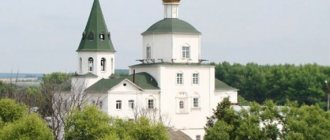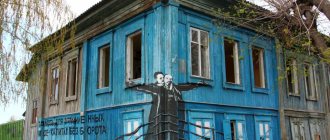For the first time we read about the city of Balakhna in a chronicle in 1536: after the attack of the Kazan Khan Safa-Girey on the salt workers’ village, the settlement was protected by a wood-earth fortress. It is unknown what source the learned compilers of the “Encyclopedic Dictionary of Brockhaus and Efron” used at the end of the 19th century, designating the year of Balakhna’s birth as 1474—then the exiled Novgorodians found the Balakhna Usolye.
Salt replenished the reserves of the royal treasury; serving people received their salaries with salt. Balakhna was engaged in salt production until the beginning of the 19th century.
Peter I had high hopes for the Balakhna shipyards. At the beginning of the 18th century, Balakhna was the main center of shipbuilding on the Volga. A century later, the history of the production of steamships, and later motor ships, began. And at the beginning of the 20th century, the last wooden barge was built in Balakhna.
Another craft of the Balakhna woodcarving masters - the art of making tiles - has also sunk into oblivion. And once upon a time, wooden forms for decorating Moscow itself were ordered from Balakhna.
For 200 years, Balakhna delighted with its airy lace; now only a few craftswomen keep the secrets.
The formation of modern industry began with the construction of the Nizhny Novgorod State District Power Plant, a pulp and paper mill and a cardboard factory.
The names of rare masters of the past have been preserved by time, but one name of a local native, awarded with organizational talent, is still glorified by the Russian people today - Kuzma Minin, a man with a king in his head.
Balakhna
Entrance to the city from Nizhny Novgorod Entrance to the city from the Trans-Volga region
My roots connect me with Balakhna. My ancestors are from Balakhna, I was baptized in the Sretenskaya Church. And on Komsomolskaya Square there is a memorial where there is an inscription Ozhigin P.A. - this is my great-grandfather (who went missing near Stalingrad during the Great Patriotic War)
• The Balakhna Chronicle is full of events, like a thick solution of salt. It is no coincidence that, along with Gorodets and Arzamas, it is included in the list of the first hundred historically valuable cities in Russia. Balakhna has long been famous for its salt mining. The original name of the settlement sounded like “Salt on Gorodets”. Balakhna Usolye in the 15th-16th centuries was known throughout the Russian state.
Since 1474, the settlement of Balakhna was given the status of a city. By decree of Elena Glinskaya, mother of Ivan the Terrible, the Balakhninskaya fortress was built in 1563. And in 1552, Tsar Ivan IV the Terrible visited our city. In the memory of descendants, the Balakhna shipyard is associated with the activities of Peter the Great in the formation of the domestic fleet. Here ships were cut for the Azov campaign of 1695, and, later, in 1722, to replenish the Baltic Fleet with auxiliary ships. Balakhna shipbuilders were considered unsurpassed masters of construction, beauty and strength. For Catherine II's journey along the Volga in 1767, craftsmen created the Tver galley.
In Balakhna, bricks and glazed colored tiles were fired. The famous Balakhna tiles shine on St. Basil's Cathedral and decorate the Faceted Chamber of the Moscow Kremlin.
You can’t ignore Balakhna lace. They were superior in quality and variety of designs to Belgian lace. Every year, through the Nizhny Novgorod Fair, Balakhna lace was sent to Paris, Vienna, London, New York, and China. Balakhna is also famous for bobbin lace making. The city developed the “Balakhna style” of lace weaving, which was based on the multi-pair technique. Preserving ancient traditions, Balakhna masters and craftswomen are still famous for their products - the famous Balakhna lace.
Balakhna was also honored by the past, twentieth century, with a unique paper mill - a manufacturer of products for the publication of the country's main newspapers. In 1925, the Gorkovskaya State District Power Plant began its work. The cardboard plant produced its first products in 1928.
Monument to Kuzma Minin But the highest pride and glory of the city is its native Kuzma Minin, named in ancient years as the first citizen of Russia, and this alone gives Balakhna the right to occupy the brightest page of national history, dedicated to the heroism of our people. Throughout the history of their city, Balakhnin residents were active defenders of the Russian land. They also contributed to the victory of the Soviet people over fascism. Balakhna gave the homeland seven heroes of the Soviet Union, of which the title of twice hero was awarded to Lieutenant General of Aviation V.G. Ryazanov
• The city was founded in 1474 under the name Sol-na-Gorodets. After the Kazan Khan razed it to the ground in 1536, a wooden fortress was built to protect against Tatar raids. In the Middle Ages, the city was a significant center of the salt industry and the administrative center of the Balakhninsky district. Balakhna is the birthplace of Kuzma Minin, the organizer of the Nizhny Novgorod militia of 1611-1612. In 1714, Balakhna became part of the Nizhny Novgorod province as a district town. In the 18th-19th centuries the city was an important shipbuilding center. In 1925, the Nizhny Novgorod State District Power Plant, operating on peat, came into operation, and in 1928 the pulp and paper mill and cardboard factory produced their first products. (Wikipedia)
• In the 17th century, B. became a district center and was one of the largest cities. Of the 254 cities of the Russian state. In terms of the number of households, B. was in 12th place and only half inferior to N.N. (1066 households) 1671 - there were households :
• Balakhna – 514 • Simbirsk – 510 • Kazan – 310 • Oryol – 80
In 1478, Ivan III conquered Veliky Novgorod. According to popular legend, it was the exiled Novgorodians who began the intensive development of salt springs in Balakhna. The salt production was in the hands of feudal lords and merchants. Among the owners were Bal. salty brewhouses are mentioned: Moscow Church, Trinity-Sergeevsky Monastery, Pokrovsky Monastery. In its heyday, production reached a million poods. Salt was transported in ships along the Volga and Oka. At the end of the 17th and beginning of the 18th century, the salt production in Balakhna began to decline. And by the end of the 18th century it almost stopped. Balakhna salt could not withstand the competition with Perm and Elton salt. The salt production was in the hands of feudal lords and merchants. Mentioned among the owners of the Balakhna salt pans are: the Moscow Tsar, the Trinity-Sergievsky and Pokrovsky monasteries, the boyar Vorotynsky. During its heyday, production reached a million poods
Salt was very expensive, so there were ancient Russian weights: 1 berkovets = 10 pudam = 163.8 kg 1 pud = 40 pounds = 16.38 kg 1 pound = 96 spools = 0.409 kg 1 spool = 96 shares = 4.26 g There were proverbs about weight measures: “In price one is free, but in weight one is not free” “The price is one’s own, but the scales are the sovereign’s” “Weight and measure, then so is faith” “Weight and measure will not be allowed to sin” Mom told me that, being As a schoolgirl, she saw the remains of salt wells on the banks of the Volga River. For the first time in Russian chronicles, Balakhna was mentioned in 1536 “by order of the great sovereign Ivan Vasilyevich of All Rus' and his mother, the great empress Elena, the city was founded by God’s mercy…………..for the sake of the fact that the settlement is large and there are many people” (complete collection of Russian chronicles vol. 29 page 24)
Balakhna was famous for its shipbuilding. In 1636, Balakhna shipbuilders took part in the construction, by order of the Holstein embassy going to Persia, of one of the largest ships of that time, the Friedrich. It was the first ship built in Russia.
During the reign of Peter I, Balakhna was one of the centers of ship construction. In Balakhna, by order of Peter I, ships were built for the Azov campaign. In 1699, he called craftsmen to Balakhna to teach shipbuilding of military sailing ships. (Balakhna Museum of Local Lore)
Balakhna
, city in the Russian Federation, Nizhny Novgorod region, pier on the river. Volga (Cheboksary Reservoir). Railroad station. 31 thousand inhabitants (1992). GRES. Pulp and cardboard mill. Museum of Local Lore. Founded in 1474. Near Balakhna - Balakhna pulp and paper mill.
Balakhna Culture
(in archaeology), the Neolithic era (late 4th - 3rd millennium BC) in Wed. Volga region. Named after the site near the town of Balakhna. Settlements of 3-4 semi-dugouts with cellars and utility pits. Stone tools, ceramics. Economy: hunting, fishing. (Big Encyclopedia of Cyril and Methodius 2003)
Sights of the city of Balakhna
- Balakhna Museum of Local Lore;
- estate of the merchant Khudyakov, historical and cultural center;
- house of merchant Alexandrov, children's museum "Solonitsa";
- modern sports and fitness center;
- cultural and leisure;
- Church of the Nativity of Christ, Sretenskaya, Pokrovskaya, Spasskaya and the oldest St. Nicholas churches;
- Zoo "Little Country", a branch of the Nizhny Novgorod Zoo "Limpopo".
The city maintains a hotel for guests.
All attractions are marked on the map of Balakhna with houses.
Churches
- Sretenskaya Church
The Presentation Church (1807) stands on the left bank of the Zheleznitsa River and is located in the village of Kubentsevo, which only recently became part of the city. It faces the road with its eastern altar façade. This cubic building is completed with triangular pediments on all four facades, with chapters mounted on the ridges of the eight-pitched roof. In the composition of the complicated five-domed structure, in the treatment of the walls, the shape of the windows of the church, as well as the top of the gate, vestiges of the Baroque of the mid-18th century are still felt. Small decorative drums support bulbous heads so wide that they barely fit above the roof of the building. The cornices of the pediments with crackers and other elements of classical profile are hewn out of brick, and modular and other details characteristic of the architecture of classicism are also made, which during this period were usually made of plaster and plaster casts. At the same time, there are signs of a transition to a new, more strict nature of architecture, according to which order forms are applied more consistently. The simple capitals of the pilasters, like all the details of the cornice, are carefully hewn from brick. Unfortunately, now, under thick layers of plaster and many layers of paint, their structural basis is almost invisible. This evidence of a realistic understanding of the connection between form and structure, still alive in those years among the Balakhna masons, does not reach the viewer now. A tall three-tier bell tower, built in the same style, complements the ensemble with its slender volume, surrounded by a fence with a stone gate of a clearly Baroque silhouette.
- Church of the Nativity
Not far from the Intercession Monastery you can see the heads of another 17th century monument—the Church of the Nativity of Christ. In the XVI-XVII centuries. on this site was the Nativity Convent, abolished in 1764. It is known that in 1618 there was a wooden tent church in the monastery. The hundredth charter of Balakhna in 1674 speaks of a stone monastery church, which had not yet been consecrated. Obviously, its discovery, which was completely ready at the time the inventory was compiled, took place no later than the following year, 1675. The style and nature of the execution of the cornices, window frames and other profiled brick parts are fully consistent with this date. The Church of the Nativity of Christ is built in the form of a clear cubic volume. Its walls are traditionally divided into three parts by blades, each of which ends with a zakomara. On the smooth planes of the white walls, the windows and their frames take up little space. The simple cylindrical drums end in five helmet-shaped domes covered with shiny green tiles with archaic crosses, similar to the examples of the 15th-16th centuries. The squat altar apses emphasize the height of the walls and the geometric regularity of the edges of the main volume. On three sides the church was surrounded by a one-story gallery, later turned into a closed porch. Cubic low aisles were attached to the church from the north and south. They each have one chapter, the transition to which was served by stepped tiers of kokoshniks, now hidden under an iron roof. Above the southwestern corner of the gallery stood a bell tower, which was later dismantled. Despite its relatively small size, the simple contours of the Church of the Nativity give the impression of calm grandeur, which is greatly facilitated by the contrast of its main volume with the plastically more developed, but small chapels. Both in the church and in the chapels, iconostases from the 18th century, decorated with characteristic Baroque carvings, have been preserved.
- Trinity Church
The architecture of the Trinity Cemetery Church, built in 1784, is also not typical for this time and rather resembles the forms of the early 18th century.
The church has the appearance of an octagonal tower based on a quadrangle, divided into two tiers of equal width and covered with a dome with a decorative dome. Adjacent to the church from the west is the refectory, which has a modestly crafted entrance at the end. The bell tower, which no longer exists, stood separately and also had the shape of an octagonal tower, similar in size and volume to the church. The church was built with great skill. A subtle understanding of the architectural plasticity of the wall is expressed here, for example, in the fact that the details of the window frames of the upper tier of the octagon, with a similar design, have a smaller relief than similar details of the lower tier. The brick gate leading to the Trinity Church is very colorful, with its small dome and tiled covering. Balakhna is a city founded in 1474. Along with Arzamas and Gorodets, it has the status of a historical city of the Russian Federation.
City `s history
The unusual name of the city is explained by several legends. One of them connects the name of the city with the order of Tsar Ivan the Terrible to issue white robes to people who worked in salt mining, the other with the presence of a large number of swamps (“balakhtin”), and the third with the fact that the development of the future city took place spontaneously: there was no Entry and exit security was established, there were no controls, which is why the saying appeared: “It’s Balakhna, the floors are wide open.”
There are several versions of the origin of the name. It is associated with the Russian words “balakhna” - “a gate, clothes or mouth, spread, spread, attributing this to negligence”: this refers to the nature of the layout of the city, which is very large in area; “balakhontse” is a section of open water in a large area: the city is located in a damp place. EM. Murzaev believes the origin of the name. Persian, from “balakhna” - upper structure, high structure. There are also opinions that the name. g. comes from the word “hoodie” - they worked in local saltworks in these clothes, from the name. R. Volkhov: the first settlers of Balakhna are exiled Novgorodians “Volokhons”. In the Middle Ages it was sometimes referred to as Usolye, Sol on Gorodets.
After the conquest of Veliky Novgorod by Ivan III in 1478, Novgorodians familiar with salt making were exiled here, which contributed to the revival of salt production. For many centuries, Balakhna was the largest salt production center, competing with salt on the Vychegda.
Balakhna is the birthplace of the patriot of the Russian land Kuzma Minin, who together with Dmitry Pozharsky at the beginning of the 17th century gathered a people’s militia that liberated Moscow from interventionists and contributed to the election of the Romanovs to the Russian throne.
Since the middle of the 17th century, Balakhna became a major shipbuilding center. Local shipbuilders built plows for the Azov campaign and participated in the construction of ships for the Holstein embassy. Ships, especially trading ships, were decorated with rich carvings. The former glory of the city is reflected in the coat of arms, which depicts two kokoros in a silver field, signifying the noble construction of the ships. Every year more than 60 different ships were launched from the Balakhna shipyard.
The famous salt industrialist and merchant of the living room of the hundred, Grigory Dobrynin, in memory of his father and brother, built a house church of the Savior in Balakhna, in Kuznechnaya Sloboda (1668-1702).
The church was richly decorated with polychrome Balakhna tiles. In the very center of the city, on the territory of the former Intercession Monastery, there is the second most ancient architectural monument of the Nizhny Novgorod region - a stone tented temple - St. Nicholas Church. It was built in 1552 in honor of the conquest of Kazan. Excellent examples of Russian architecture of the 16th and 17th centuries are the Church of the Intercession and the Church of the Nativity of Christ (1675), in which the iconostasis of the second half of the 18th century, decorated with Baroque carvings, has been preserved.
At the turn of the 17th - 18th centuries, Balakhna became one of the centers of tile production in the Russian state. Balakhna tiles decorate St. Basil's Cathedral in Moscow on Red Square. All stone buildings of the 17th century in Nizhny Novgorod were erected from Balakhna brick.
Balakhna is also famous for lace-weaving on bobbins. The city developed the “Balakhna style” of lace weaving, which was based on the multi-pair technique. The collection of Balakhna lace is in the city museum of local lore. The museum also displays icons of the 17th-19th centuries, tiles of the 16th-19th centuries, wooden sculptures of the 18th century, glass products from a local factory, an ancient sleigh, a bicycle and much more. A clock two meters in diameter is kept in the museum - a memory of the Ascension Cathedral.
The city's children's library houses a small museum dedicated to Kuzma Minin and the militia of 1612.
In Pravdinsk, which is assigned to Balakhna, there is an orphanage of culture, where Balakhna lace, wood carving are being revived, and arts and crafts are flourishing. The houses of Pravdinsk are notable for the fact that many of them are decorated with solid bas-relief carvings.
On the first Sunday of September, Balakhna celebrates City Day. On this day, townspeople remember their fellow countryman Kuzma Minin. On the main square of the city, a large theatrical event takes place, in which guests of the city are also involved; workshops of artists, carvers, potters, lacemakers, wicker weavers and whistle-makers operate.
History of the city of Balakhna.
Balakhna is an ancient Russian city. The year of foundation is 1474. A settlement existed on this site three to four thousand years before it was declared a city. Under its own name, Balakhna was first mentioned in Russian chronicles since the construction of a fortress in it in 1536. This year, the Kazan khan Safa-Girey practically destroyed the city. After this, the mother of Ivan the Terrible, Elena Glinskaya, ordered the construction of a fortress here, which burned down in 1730. A selection of photographs. A distinctive feature of the economic and historical development of Balakhna from other regional centers of the Nizhny Novgorod region is that Balakhna, starting from the second half of the 15th century. and to this day, has had three “golden ages” and played a major role in the economy of ancient Rus', pre-revolutionary Russia and Soviet Russia. These three “golden ages” of Balakhna were associated not with handicrafts, not with military campaigns and battles of the kings, but with certain industrial production: salt mining, shipbuilding, paper production and electricity for the entire country.
Balakhna in ancient Rus' was the only significant center of the salt industry. According to folk legends, the development of salt springs began here by exiled Novgorodians after the conquest of Veliky Novgorod by Ivan III in 1478. Historian S.I. Arkhangelsky writes that Balakhna in the 16th-17th centuries. “had certain industrial features, starting from numerous churches built by salt industrialists, and ending with the wretched cell of a peasant who worked in the same fields.” In the 70s XVII century, namely in 1674-1676. in Balakhna there were 33 brine pipes with almost 25 thousand tubs of brine, which was evaporated in 86 brewhouses, resulting in salt. Salt was sold locally, but most of it was exported in plows along the Volga, Oka and Klyazma.
Balakhna is the birthplace of Kozma Minin (late XVI - 1616), the organizer of the Nizhny Novgorod militia of 1611-1612. The time of birth of Kuzma Minin has not been precisely established. It is believed that he was older than Dmitry Pozharsky and was born around 1570. Minin grew up in the large family of Balakhna salt miner Mina Ankundinov. Cosma Minin's father was a wealthy man. From childhood, Kosma took part in his father’s work, as was customary in all Russian families, regardless of financial or class status. He wielded an ax and a scythe, handled horses, and was familiar with the hard work of salt mining. When Cosma was about twelve years old, he and his father and mother Dominica moved to Nizhny Novgorod. Later, when Cosma Minin had his own business, he settled in the suburb of Blagoveshchenskaya Sloboda. In the meat aisle at the Nizhny Novgorod market there was a shop of Kosma Minin, he also owned an “animal slaughterhouse”, under the walls of the Kremlin. Kosma Minin had a wife, Tatyana Semyonovna, and a son, Nefed. There is a version, which is not confirmed by archival documents, according to which Minin also had a son, Leonty. In his mature years, Kosma Minin was a respected person and was one of the wealthy people in the townspeople of Nizhny Novgorod. In 1611, he was elected head of the zemstvo, repeatedly called for the fight against the Polish-Lithuanian invaders (3 of his speeches are known), for the creation of a people's militia led by Prince D.M. Pozharsky, was in charge of its economy, showed diplomatic foresight, military talent, and eloquence . He was firm in his decisions and knew how to achieve the consent of various social groups. The militia, supplied with everything necessary, liberated Moscow from the invaders on October 22-26, 1612. Minin took part in the Zemsky Sobor of 1613 and signed the document electing Mikhail Fedorovich Romanov as Tsar. On June 12, 1613, he was proclaimed a Duma nobleman, granted an estate in the Nizhny Novgorod district (the villages of Bogorodsky and Vorsma with the village), which became his patrimony by decree of January 20, 1615. Left in Moscow. In 1614, he collected the First Pyatina around the country; on December 25, 1615, the Boyar Duma sent him to Kazan to establish peace and harmony between non-Russian peoples. Having completed his mission, he died in the spring of 1616, brought to Nizhny Novgorod, and buried in the graveyard of the parish Pokhvalinskaya Church. In 1672, his ashes were transferred to the Kremlin Transfiguration Cathedral by the first Metropolitan of Nizhny Novgorod, Philaret, and were later reburied several times. In 1962, it was laid in the Kremlin St. Michael the Archangel Cathedral - a temple-monument to the militia of the early 17th century. The Minin family in a direct line came to an end with the death of his son Nefid in 1632, the estate was assigned to the sovereign. In the 17th century Balakhna had 606 courtyards, and out of 254 cities of the Russian state it was in 12th place. In terms of the number of households, it was only half inferior to Nizhny Novgorod, which has 1006 households. But at the end of the 17th and beginning of the 18th centuries. Salt production in Balakhna begins to decline at the end of the 18th century. has practically stopped. There were several reasons for the decline of salt production: - the introduction of a duty on all salt sent from Balakhna; — the high cost of firewood, which is the only type of fuel when boiling salt; — devastating fires in 1680 and 1730, which thoroughly destroyed Balakhna; - frequent (1620, 1678, 1709, 1751, 1829, 1849) and strong spring floods of the Volga, leading to great destructive consequences. In addition to these reasons, there was another and important one - competition from other salt-producing regions of Russia, such as Perm, Elton and Iletsk, where the brine solution was more saturated and firewood was much cheaper. In terms of a larger amount of boiled salt, the last year was 1870. By the end of the 19th century. salt production stopped. Thus ended the first “golden age” of Balakhna. Along with salt making, the Balakhna people were known in Rus' as first-class shipbuilders, and Balakhna has been famous for its shipbuilding since ancient times. The Balakhna builders showed their real art in 1636, when they built one of the largest ships for that time (the first built in Russia), the Friedrich, by order of the Holstein embassy. From that time on, the second “golden age” of Balakhna began. During the reign of Peter I, starting in 1699, Balakhna became one of the centers for the construction of sailing military ships for the Tsar’s Azov campaign. Not only local residents worked on the construction of ships, but also craftsmen who came from Kostroma, Vladimir and other provinces. After the Balakhna Usolye froze, shipbuilding began to play the most prominent and important role in the industrial life of Balakhna. In 1845, Balakhna residents began building steamships and barges. About 100 barges were built in Balakhna every year. However, barge building continued only until the end of the 19th century. Balakhna shipbuilding could not withstand competition from the Sormovo shipyard, built in 1849 next door. In the XVI-XVIII centuries. Balakhna was famous for the production of stove and architectural tiles. Tiles were used in the construction of churches, cladding houses and laying stoves. The tents of St. Basil's Cathedral in Moscow are made with iridescent tiles made by Balakhna craftsmen. Brick masonry masters from Balakhna took part in the construction of the Moscow Kremlin. At the same time, Balakhna lace crafts were widely developed. Lace making made Balakhna lacemakers famous throughout Russia. Lace products were also sent abroad. The lace trade brought very little income to weaves (lacemakers), from the end of the 19th century. the fishery began to decline. It has survived in very small sizes to the present day. The decline of salt production and a sharp reduction in the construction of ships led to a general slowdown in the industrial development of the city, and Balakhna at the end of the 19th century. turns into a small provincial dirty provincial town with a drunkard, almost completely illiterate population and insignificant crafts: shoemaker, tailor, blacksmith, pottery. Balakhna remained this way until the October Revolution of 1917.
A new life began in Balakhna with the advent of Soviet power. In terms of electrification of Russia, the GOELRO plan, Balakhna was included in the list of priority construction projects. The area was embarking on the path of socialist industry, the basis of which was the large peat bogs adjacent to the city. Peat deposits with very large reserves of peat were also located to the west of Balakhna. By decision of the Government, construction of the Nizhny Novgorod State Regional Power Plant (NizhGRES) began near the city of Balakhna in 1923. The power plant generated its first current in 1925. In 1929, the GRES had a capacity of 42,000 kW, and in 1933 - 250,000 kW, being at that time the largest power plant operating on peat, both in the USSR and in the world. The industrialization of Balakhna continued - in the spring of 1926, construction began on an industrial giant - a pulp and paper mill, which was to become one of the largest factories in Europe. The decision to build a pulp and paper mill near Balakhna was justified by the availability of electricity, huge reserves of Trans-Volga spruce forests in the Unzhe basin, Balakhna’s proximity to Moscow - the largest consumer of paper - and Balakhna’s position on the Volga. In 1928, the first paper-making machine was launched, and Balakhna newsprint went to Moscow, so far only for the Pravda newspaper. Near Balakhna, the wallet settlement of Pravdinsk grew up. Along with the paper mill, in the first years of socialist construction, a cardboard factory was built in Balakhna, which was put into operation in August 1928. The choice of location for the construction of the factory was determined by the same reasons - the proximity of the power plant - GORES, the reserves of spruce forest along the Unzhi River, the proximity of the consumer of the factory's products . In the early years, the factory ranked first in terms of capacity in the USSR, producing 13,500 tons of cardboard per year. Simultaneously with these leading enterprises, in the first years of Soviet power, others were built and put into operation - a furniture factory, enterprises serving the city population. The Balakhna power plant, paper mill, cardboard factory (despite their new forms of ownership and names) determined and determine the economic power and face of the region, being the largest enterprises not only in their industries, district, region, but also in the country. The third “golden age” of Balakhna continues and continues successfully, withstanding new economic reforms, economic crises, as well as competition from other countries and enterprises producing similar products.
Sights of Balakhna
- Museum of Local Lore
The remains of an ancient man were found on the territory of Balakhninsky district. Household items and hunting tools obtained from the excavations are stored in the museum.
Almost 400 years have passed since the Nizhny Novgorod Militia, led by the wise Kuzma Minin and the glorious Dmitry Pozharsky, liberated Moscow from the invaders. From archival documents it is known that Kuzma Kuzma Minin comes from a large family of hereditary Balakhna salt industrialists. From his hometown K. Minin moved to Nizhny Novgorod, where he was elected head of the lower settlement. It was the zemstvo elder Kuzma Minin who organized the great patriotic resistance to the Polish-Lithuanian occupiers, forming the famous “Nizhny Novgorod Militia”, headed by K. Minin and Prince D.M. Pozharsky. In 1612, Russian lands were liberated by interventionists. Every year on May 21, Balakhna celebrates the Day of Remembrance of its native Kuzma Minin.
Routes on the map of Balakhna. Transport infrastructure
Railways
Balakhna is connected with Nizhny Novgorod and the Volga region.
Balakhna railway is located at st. Engelsa, 109.
Car roads
- Motor transport is the basis of passenger transportation in the city and region.
- Local buses: 2, 6, 7, 11, 12, 14, 51, 57, 102, 104, 105, 106, 107, 108, 109, 110, 112, 125.
- Minibuses: 7a, 17.
- Balakhna bus station - st. Dzerzhinsky, 30.
- highway R-152 goes through Balakhna .
- There is bus 203A to Nizhny Novgorod and bus 203 back.
Volzhskaya transport highway
The movement of motor ships, "Rockets" and "Meteors", as well as heavy-duty barges to the cargo pier is open.
There is no river station in the city.
Education
- School No. 14
- School No. 6
There are about a dozen schools in the city of Balakhna. Municipal Educational Institution Secondary School No. 14 with in-depth study of individual subjects is rightfully considered one of the best schools in the region. It employs passionate professionals, some of whom have become tutors for the Intel program
- …
| Cities of the Nizhny Novgorod region |
| Arzamas | Balakhna | Bogorodsk | Bor | Vetluga | Volodarsk | Vorsma | Vyksa | Gorbatov | Gorodets | Dzerzhinsk | Zavolzhye | Knyaginino | Kstovo | Kulebaki | Lukoyanov | Lyskovo | Navashino | Nizhny Novgorod | Pavlovo | Pervomaisk | Transportation | Sarov | Semenov | Sergach | Uren | Chkalovsk | Shakhunya |
Cuisine and restaurants of Balakhna
The traditional cuisine for Balakhna is Russian cuisine, but in the city, among the catering establishments, you can find a restaurant with other cuisines of the world: European, Japanese, Italian, Asian.
There are not as many cafes and restaurants in the city as in the “promoted” tourist centers, but there are quite enough of them so as not to go hungry. Among the restaurants, we can recommend “Napoleon” - an establishment of Moscow level with non-Moscow prices. Fans of Japanese cuisine should visit the Sushimin restaurant.







